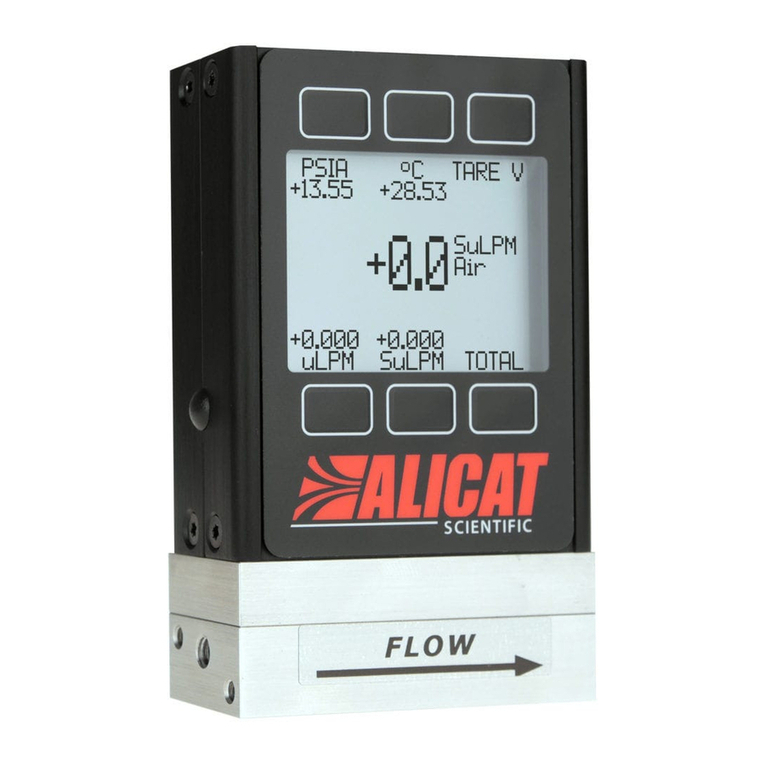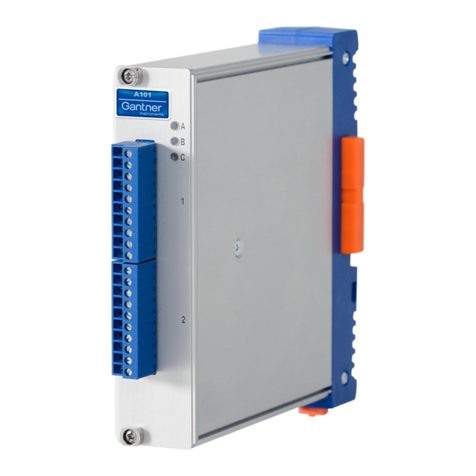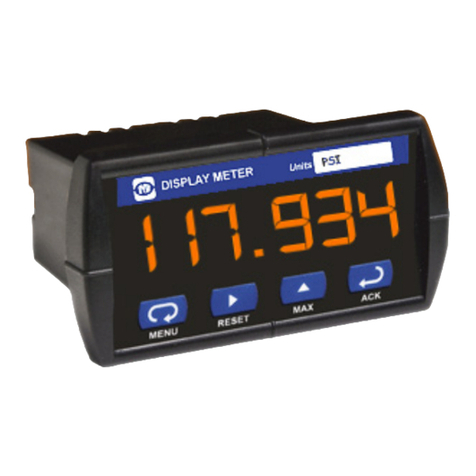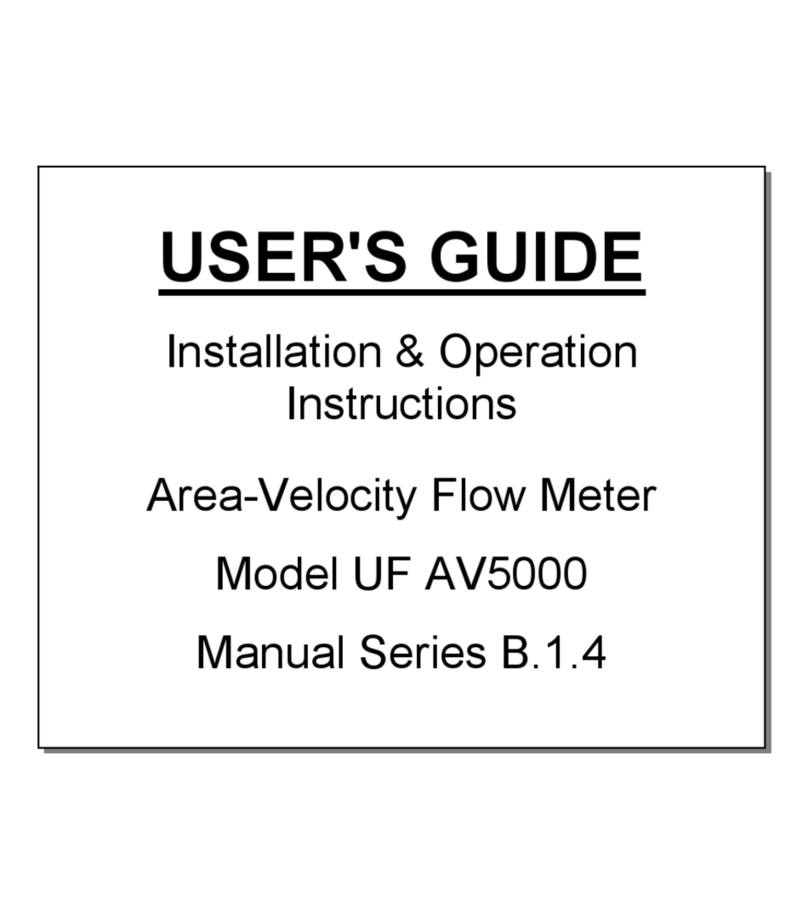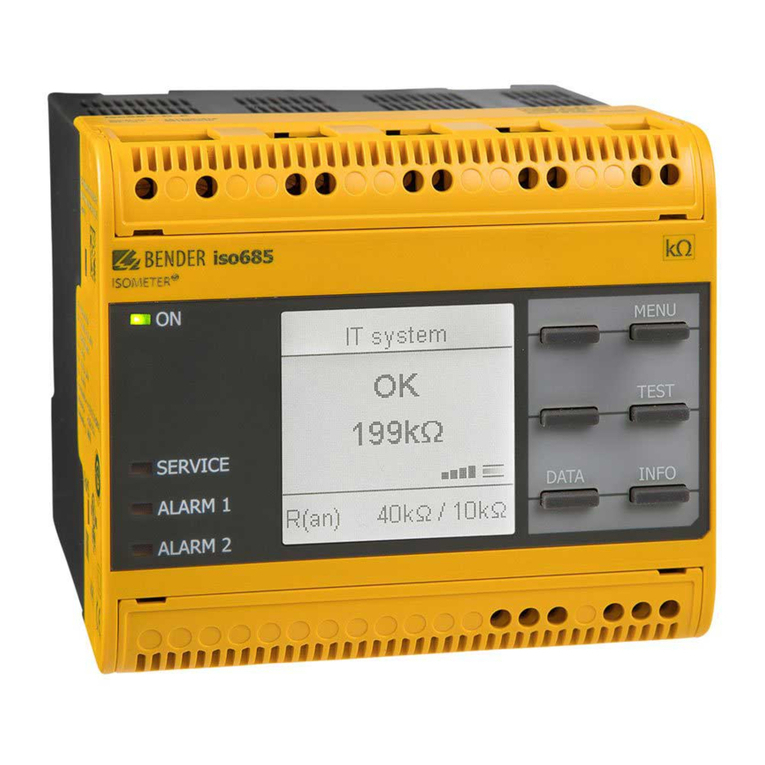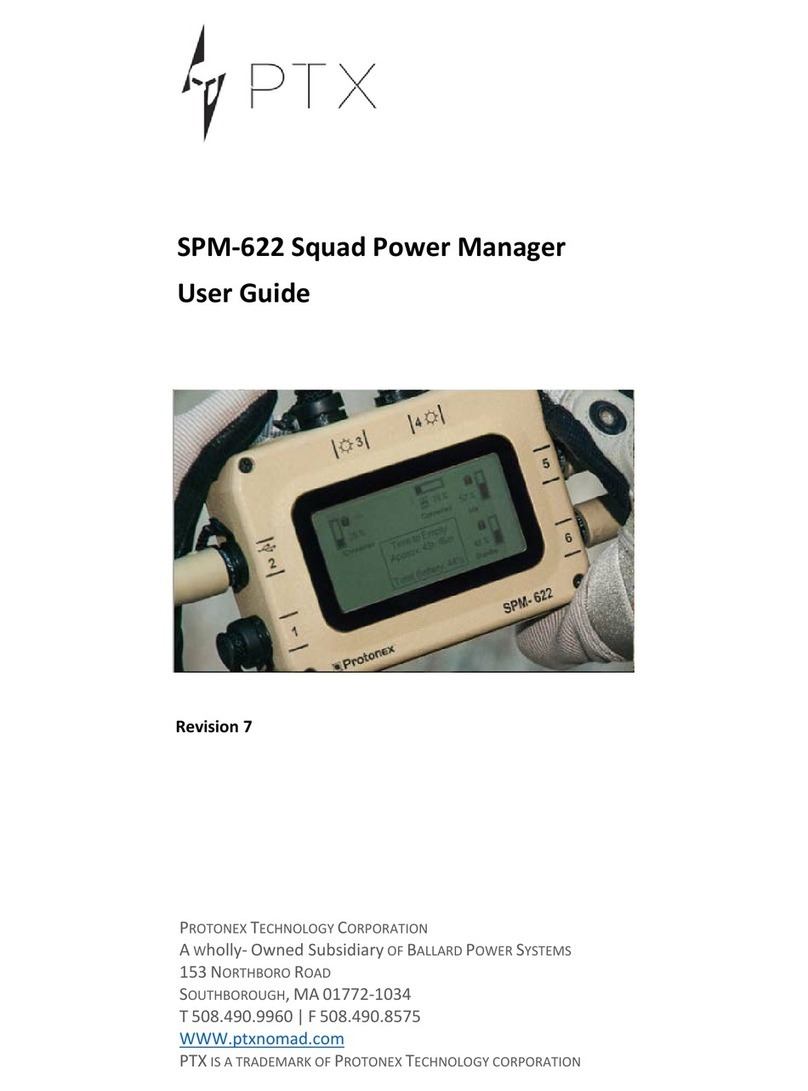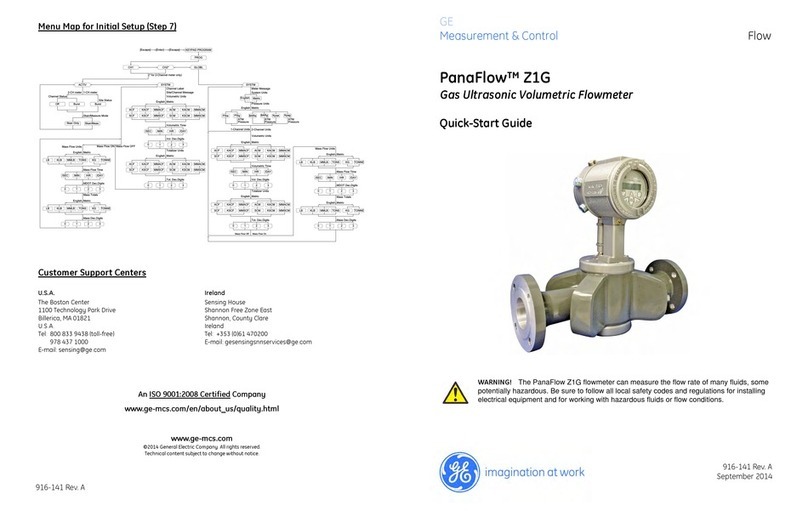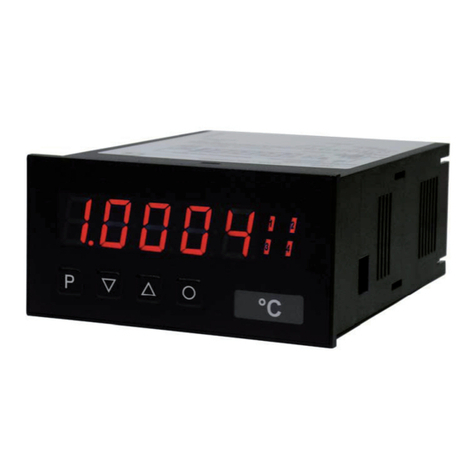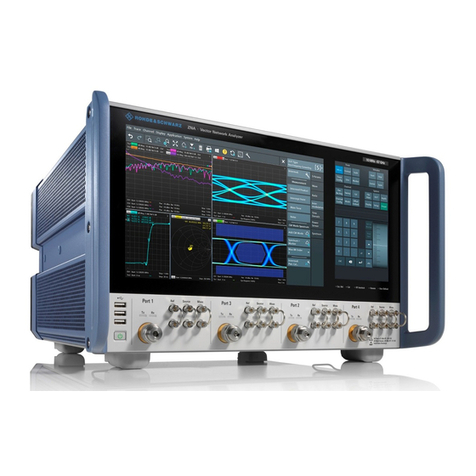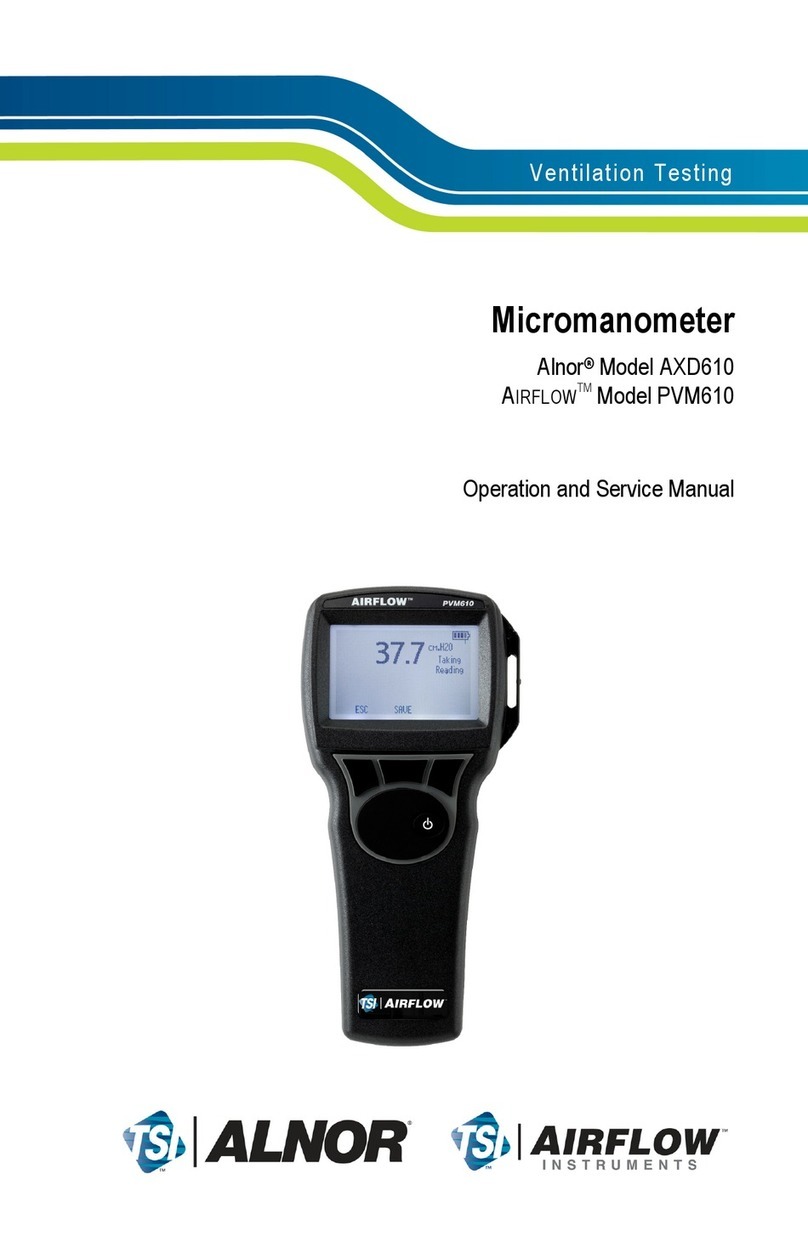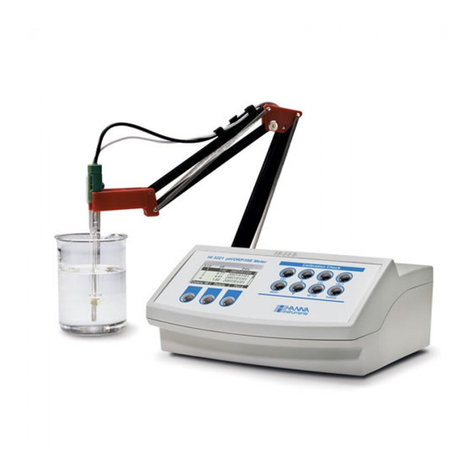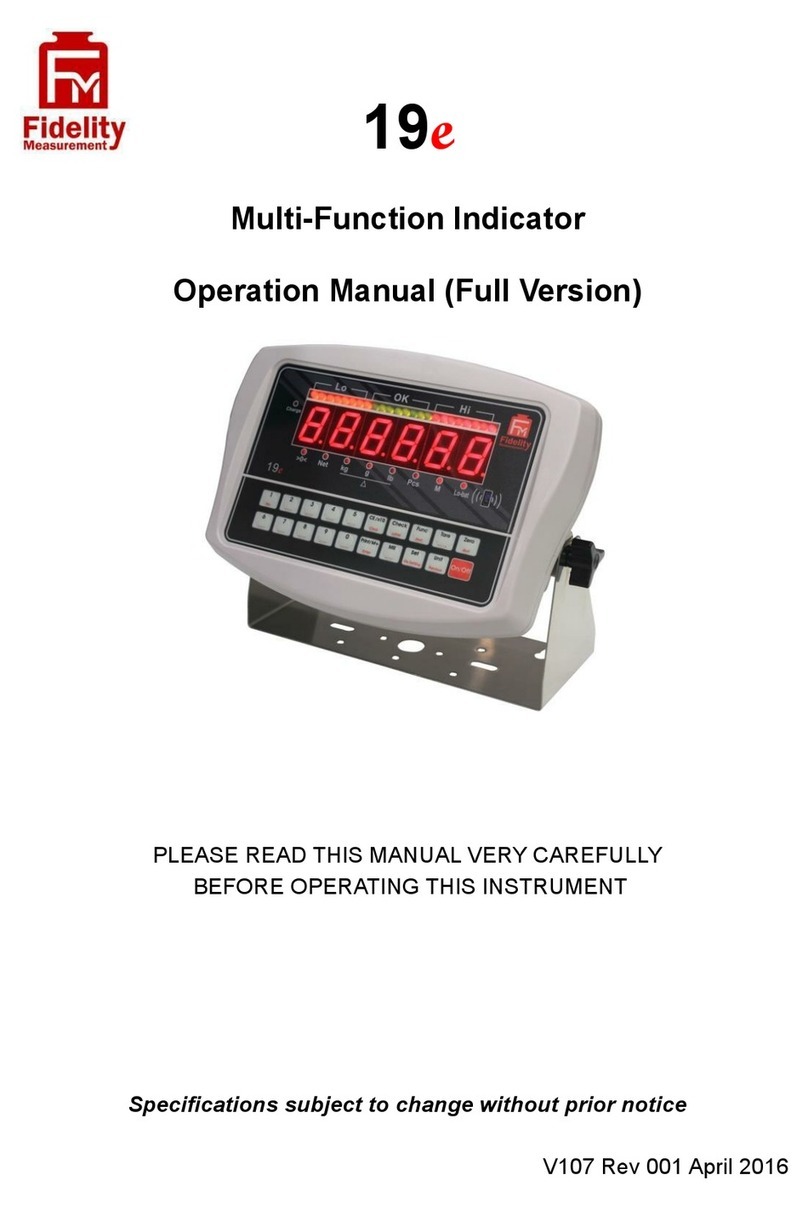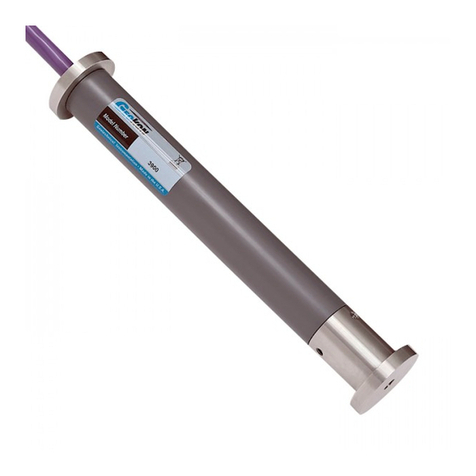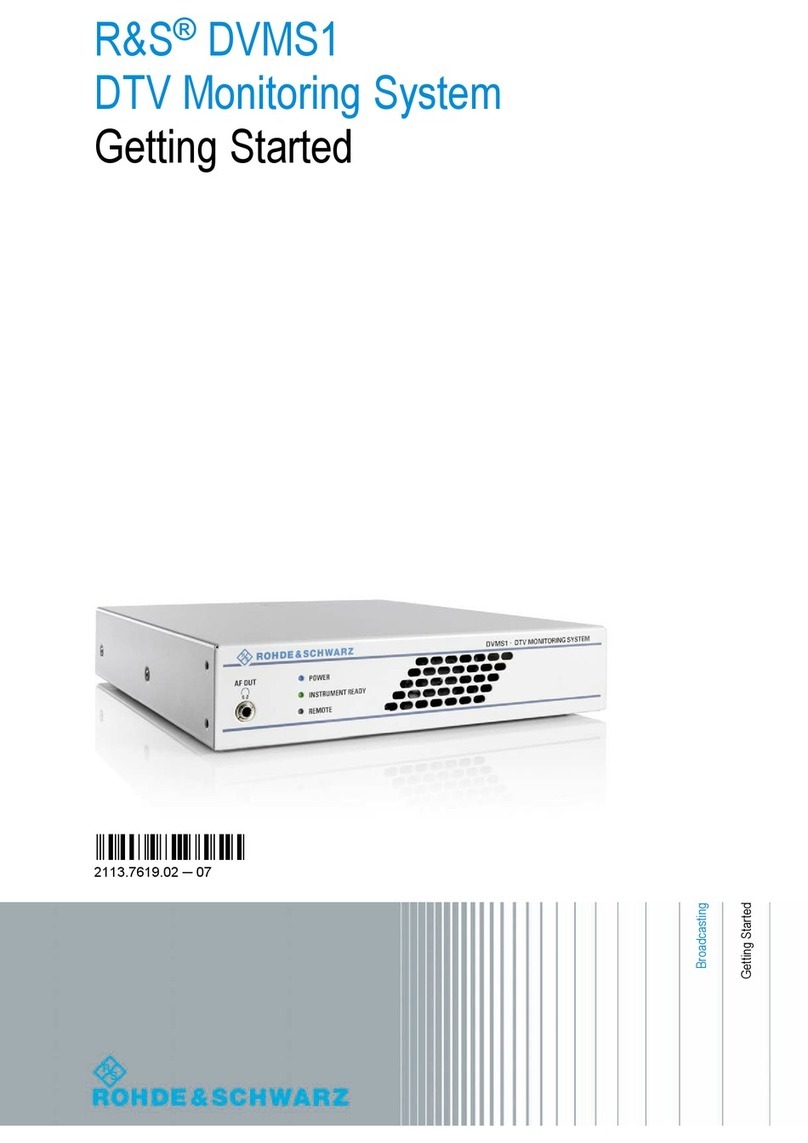Trisan S8 User manual

TRISAN S8 Portable Appliance Tester
Operating Manual

2
About TRISAN S8 / TRISAN S8 DL Portable Appliance Tester (PAT).
This tester is Trisan core technology that supports a range of customised firmware.
The S8 is the current platform for the Trio SafeTcheck tester. (PRO LOGGER ll & PLUS )
The instrument requires the operator to have a good knowledge of the types or categories of
Portable appliances. Categories are generally divided between Class l and ll.
The operator also requires an understanding between Insulation Resistance and run/ leakage cur-
rent testing.
The TRISAN S8 is designed specifically for performing tests as required by the Australian stan-
dards AS/NZS 3012 and 3760.
These standards are derived from the fundamental design, manufacture and safety Standards as
follows:
1. AS/NZS 3000.2000………...Wiring Rules
2. AS/NZS 3100 ……………...Approval and testing specification– general requirements for
electrical equipment.
3. AS/NZS 60335……………...Household and similar electrical appliances– Safety.
4. AS 4024.1 ………………….Safety of machinery.
5. AS 61010.1-2003……………Safety requirements for electrical equipment for measurement,
control and laboratory use.
6 AS 3551-2012……………….Management programs for Medical equipment.
7. AS 3112……………………..Approval and test specifications - Plugs and socket outlets.
Including:
MANAGING ELECTRICAL RISK IN THE WORKPLACE– Code of practice -
Published by SafeWork Australia.
Trisan Australia P/L. declares that this product conforms with the standards and guarantees this
Product to be free of defects in material and workmanship under normal use for a period of two
years. The period of warranty will be effective from the day of reasonable usage.
Trisan Australia P/L. is a registered with QAS International. ISO 9001:2008
Certificate No: AU 1659
All tests performed by the TRISAN S8 on portable appliances strictly adhere to these standards.
Testing Electrical Safety of Appliances with the TRISAN S8 is simple, fast, accurate, thorough
and provides an elevated level of operator safety. Testing voltages, currents and duration times are
set-up for the operator for a specified test type. This feature minimizes mistakes or stops unauthor-
ised personnel changing critical test routines. Testing operators are considered competent, but do
not have certification or qualification to compose their own testing regimes for any specific type of
appliances.
TRISAN S8 tests the safety of Class 1 (earthed) appliances, Class 2 (double insulated) appliances,
3 Phase appliances, Fixed and Portable RCD’s and extension leads in accordance with the stan-
dard, performed simply and efficiently with no ambiguity.
Regular inspection and testing of electrical appliances is about reducing risk of electric shock
or indirect injury and removing the potential for electrical fire hazards.

3
TRISAN S8 Table of contents
Table of Contents
PAGE
General description
………………………………………………………………………………………………..5
1 Warning
………………………………………………………..6
2 Battery
………………………………………………………..7
3 Definitions and explanations
………………………………………………………..8
4 Instrument Information(F1) ………………………………………………………12
Instrument description……………………………………………………………….. .………
13
1 Front panel
2 Connector panel …………………………………………………… 14
3 Back side
4 Meaning of symbols and messages on the instrument display…………………………………. 15
Technical specifications ………………………………………………………………………
. 16
1 Class 1 Earthed appliances measurements
2 Class ll Double insulated appliances measurements
3 Extension/Leads measurements
4 Earth test measurements
5 PRCD and Fixed RCD testing measurements…………………………………………………...17
Visual Inspections ………………………………………………………………………………..
18
Appliance categories and test sequence ………………………………………………………..
19
Common appliances tests
1 EARTH APPLIANCES CLASS I
2 DOUBLE INSULATION CLASS II
3 LEADS ………………………………………………………………………...19
Other appliances tests …………………………………………………………………………………… 21
Listing order use F1 or F2 to scroll up or down
4 250 V CLASS I
5 250V CLASS II
6 RUN test CLASS I
7 RUN test CLASS II
8 Earth test only CLASS I ……………………………………...23
9 MIMS Run test CLASS I
10 EPOD 250V CLASS I
11 10mA Portable RCD CLASS I ……………………………………...24
12 30mA Portable RCD CLASS I
13 10mA Fixed RCD CLASS I
14 30mA Fixed RCD CLASS I
15 PIEZO Run test CLASS I ………………………………………25
16 3-Pin Run test CLASS II
17 Long Run test CLASS I
18 3 Phase Run CLASS I ………………………………………..26

4
TRISAN S8 Table of contents
Installation of driver software on PC to enable communication with TRISAN S8
………………… 27
Quick Start Guide to Downloader software
…………………………………………………………………. 28
Utilities menu (F2) ……………………………………………………………………………..
29
Listing order (use F1 and F2 to scroll up and down)
Working with data base
1 Upload test results
2 Delete test results
3 Enable database
4 Ask for venue
5 Ask for technician
6 Ask for appliance or asset number
7 Ask for visual P/F
8 Ask for tag number
9 Ask for comment
Miscellaneous utilities 10 Earth Continuity 0.2A …………………… . 30
11 Routine Test 10A
12 Type Test 25A
13 Measured values
14 Adjust Display……………………………………. 31
Working with data base
15 set time/Date ……………………………………… 31
16 checkCONNECT…………………………………. 32
17 Fail on poor cont………………………………….. 32
18 Earth threshold …………………………………… 32
Print test tags 19 Printer Enable ……………………………………… 33
20 Set retest period ……………………………………….33
Communications
………………………………………………………………………………………………34
Maintenance
………………………………………………………………………………………………35
1 Periodic calibration
2 Replacement of batteries
3 Service
4. Cleaning and care
5. Registration of your TRISAN S8
Instrument accessories
………………………………………………………………………………………..36
Manual Revision
……………………………………………………………………………………………… 36

5
TRISAN S8 General description
General description
The multifunctional portable appliance tester TRISAN S8 is intended to perform measurements for
testing safety of portable electrical equipment.
The following tests can be performed:
› Visual inspection (acknowledgement only)
› Earth continuity resistance
› Insulation resistance
› Insulation resistance of isolated accessible conductive parts
› IEC cord polarity test
› Differential leakage current test
› RCD and PRCD tests
› Supply line voltage check before each run test.
› Functional test on run socket only
› 3 Phase leakage current testing (Can be conducted under battery powered mode).
Some instrument highlights:
› Power supply from both mains power and batteries
› Graphic LCD with resolution of 128 x 64 dots, with backlight
› Large data flash memory for storing test results and parameters (approx. 2000 tests can
be stored)
› USB communication port for communication with PC, barcode scanner, printer
› Additional connectors for fixed appliances testing
› Built-in real time clock
› Fully compatible with FastTag, and simplyPATs database packages.
› Pre-programmed test sequences for operator safety
› Download utility software
The graphic display with backlight offers easy reading of results, indications, measurement
parameters and messages. Two LED Pass/Fail indicators are placed at the sides of the START
AND RESET buttons.
The unit is very intuitive to use and therefore the operator does not need any special training
(except reading this instruction manual) to operate the instrument.

6
TRISAN S8 General description
1.1 Warning
In order to reach a high level of operator safety while carrying out various measurements using the
instrument, as well as to keep the test equipment undamaged, it is necessary to consider the
following general warnings.
› Warning on the instrument means » Read the Instruction manual with
special care to safety operation. This symbol requires action!
›Read the instruction manual carefully.
›If the test equipment is used in a manner not specified in this instruction manual the
protection provided by the equipment may be impaired!
›Do not use the instrument and accessories if any damage is noticed!
›Do not touch any test leads/terminals while the appliance is connected to the
TRISAN S8 while testing is in progress.
›Consider all generally known precautions in order to avoid risk of electric shock while
dealing with hazardous voltages!
›Use only correctly earthed mains outlets to supply the instrument!
›The mains supply voltage has to be higher than 90VAC. otherwise the internal power
supply could be damaged.
›Use only standard or optional test accessories, supplied by your distributor!
›Instrument servicing and adjustment MUST be carried out by Trisan
Australia service and calibration centre, Adelaide.
› Hazardous voltages can exist inside the instrument. Disconnect all test leads, remove
the power supply cable and switch off the instrument before opening the battery
compartment.
Ensure before testing appliance, CLEAN APPLIANCE PLUG before
inserting into tester. Dirt and contaminates will build up inside test sockets
which create a false earth measurement reading. DO NOT TWIST appliance plug
when inserted in test socket to make a good connection.

7
TRISAN S8 General description
Battery
The battery feature allows the tester to perform insulation and some leakage current tests. RCD
tests require batteries to be installed.
The battery is essential to hold date and time information. Operating with a printer and or
data logging mode, it is important that the date is accurate. Always check the time and date
by pressing the F1 menu button. (F1 ↑)
The instrument uses six AA size NiMH, Alkaline or Lithium battery cells.
Whether using Alkaline or NiMH batteries one to two thousand tests are achievable.
A prompt will be displayed to indicate when batteries are getting low. This prompt will reappear
regularly until action is taken to replace batteries.
BATTERY INSTALLATION.
♦
When installing batteries, the instruments battery compartment can contain hazardous volt-
age inside! Before opening the battery compartment cover, disconnect all accessories con-
nected to the instrument and switch off the instrument.
♦
Ensure that the battery cells are inserted correctly otherwise the instrument will not operate
and the batteries could be discharged.
♦
If the instrument is not to be used for a long period of time, remove all batteries from the
battery compartment.
♦
Rechargeable NiMH batteries type 6 (size AA) can be used. We recommend only using re-
chargeable batteries with a capacity of 1900 to 2600mAh.
♦
Dispose of batteries responsibly

8
TRISAN S8 Important Read General description
Definitions and explanations
If in doubt ask! Contact us
There are technical words and phrases that have specific meaning related to the standards and the Tester that may not
be understood by the operator of this instrument. The following is a list of these words, meanings and explanations.
Active (A) - Neutral (N) continuity The copper circuit loop (conductor) which electric current flows to power elec-
trical appliances. The importance of electrical continuity is to ensure the testing voltage is applied directly to the
appliance internal electrics and not just applied between the plug through the power cord to the on/off switch.
Supply voltage (110-265VAC) is applied between each end of the copper loop to drive the current around and
through the appliance.
Circuit: is the active to neutral loop via the appliance internal electric load resistance or impedance that current flows.
Closed circuit: if the loop is not broken or if a switch is closed
Open circuit: the loop is broken or switch is opened
Circuit resistance: limits amount of current flow through the appliance measured in ohms.
Hi Z or impedance: a highly resistive circuit greater than 100k ohms. Frequency dependent resistor. The resistance
cannot be measured by simply ohm-meter or multimeter. Relevant frequency range 45 to 400 Hz.
Portable appliance: equipment that is frequently moved from place to place, plugging in and out of power outlets
frequently in use.
In-service appliance: an appliance that is in use. This is the appliance that requires inspection, test and tag.
Out of service appliance: shall not be safety tested until serviced by electrician. The electrician is required to test for
safety after repair.
Stationary appliance: Equipment having a mass exceeding 18kg. These items are not considered portable appliances
and do not require regular safety testing if the responsible person considers the appliance to be low risk. Appliances
such as fridges fit this category provided it is directly connected to a power outlet and not connected via a power board
or extension lead.
Colour coding safety tags: Recommended but not mandatory. Union construction and mining sites will not allow
appliances on sites unless the tag colour readily indicates the retest date.
Red December to February
Green March to May
Blue June to August
Yellow September to November
Other colours for coding maybe suitable.
Cloak: An electrical conductive material that is used to tightly cover the surface of an appliance which acts as an earth
screen for hazardous leakage currents. The cloak may be of steel, copper and aluminium flexible material.
The material used must be kept clean of dirt, oil, oxides and salty materials or may influence test results.
Unless the cloak measures below 1 ohm it must not be used in Class ll run tests.
Isolation: Insulation of an appliance between the power supply inlet and outlet or metal exposed parts.

9
TRISAN S8 Important Read General description
Definitions and explanations
If in doubt ask! Contact us to provide further explanations
Work hardening copper: A mechanical process of continual flexing or vibrating soft copper until the material be-
comes brittle and fractures. This is the process which occurs in leaded appliances. By observation a lead becomes stiff
and has a memory of shape rather than pliable with a soft lay. These leads become dangerous, the multi stranded cop-
per become hard and brittle eventually piercing the insulated cord. The result will cause a fire or create carbon that
will conduct around the surface of the break, leading to possible electric shock. This is quite a common occurrence in
older appliances which is why inspection and testing has become so important.
Body resistance:
The voltage necessary for electrocution depends on the current through the body and the duration of the current.
Ohm’s Law states that the current drawn depends on the resistance of the body. The resistance of human skin varies
from person to person and fluctuates between different times of day. Under dry conditions, the resistance offered by
the human body may be as high as 100,000 Ohms. Wet or broken skin may drop the body's resistance to 1,000 Ohms,
adding to that high-voltage electrical energy quickly breaks down human skin, reducing the human body's resistance
to 500 Ohms.
Insulation: A material that does not conduct electrical current. However, these materials can become conductive by
contaminates such as salts, carbon and small fragments of metal particles etc.
Electrical cords and appliances behave in a similar way to body resistance, given the environmental conditions
(temperature, humidity, mechanical movement and wear, conductive particles and acids in the atmosphere will vary
the dielectric strength of the insulation resistance. Only by applying sufficient electrical strength over time across the
insulation barrier will degrading dielectric material be measured. The higher the electric voltage applied for several
seconds will induce potential weaknesses in an insulated body. With reference to standards these testing voltages lie
between 250 to 500VDC or 240 to 1500VAC ( high pot isolation testing can be as 3750 to 10,000VAC).
If there is an insulation weakness the high electric field ionises this zone, creating localized heating. Any partially
conductive contaminates will break down the resistance even further to a point of flash over. (Total insulation break-
down). Relatively low test voltages as 250 or 500VC will produce similar results but not as severe and resistance of
the insulation may fall to several hundred ohms. Reduction below 1M ohm is a failure according to AS/NZS 3760.
Lower test voltages will not produce the electrical strength required to impart the effect as described above. Substi-
tute leakage current testing is no better than using a resistance measurement on a multimeter (test voltage 40–
50VAC). Breakdown of insulation is non-linear not linear as determined by this test. Multiplying a measured leak-
age by a factor of 6 does not equate to the same leakage determined by an electric potential of 250VDC. The behav-
iour of an insulation breakdown would follow an exponential law but the characteristic nature of the breakdown will
determine the end result.
Substitute leakage current testing does not guarantee an electrical A - N continuity circuit or a measure of isolation
between input and output. No recognized electrical standard governing substitute leakage current testing.
For this reason appliance testers are specified instead of general purpose resistance meters. Appliance testers with ap-
plied high test voltages to equipment will accelerate breakdown of possible or potential flaws in insulation as de-
scribed above.
Be cautioned some testers on the market use extra low voltage to test for insulation breakdown. (check specifications
before purchase). There are no standards which prescribe this type of testing. Portable appliance testers whose fea-
ture’s list like a multimeter’s description should be avoided. Competent operators other than electricians/engineers
have no training in insulation materials and their behaviour, guidance is generally from the retailer and the little infor-
mation received from training courses.
The testing of in-service electrical appliances is about finding the potential onset of hazards, not just the obvious
breakdown that substitute leakage current testing will only find. Using this method of testing 99.9% of the appliances
tested will pass. Reliance on visual inspection becomes most important.

10
TRISAN S8 Important Read General description
Definitions and explanations
If in doubt ask!
Competence: demonstrated ability to apply knowledge and skill. If you have only completed a training course on test
and tag, where your new found knowledge is not assessed or certified does not make you competent.
Insurance cover for this vocation does require certification.
Inspection and test person:
• Person who has received training in this vocation
• Should work under guidance from an electrician, electrical engineer or electrical inspector.
• Responsible to a responsibility representative/person or officer of a body corporate.
• Should not give advice only opinion or suggestion.
• Consults and document tasks as requested.
Responsible person: Shall be considered as: the owner of business or premise, the owner of electrical appliances.
A person who has legal responsibility for the safety of electrical equipment.
Responsible person shall:
• assess the knowledge and integrity of a competent person before undertaking tasks.
• inspect the appliance testers and accessories that they are in good condition. The equipment shall display a
current calibration label and electrical safety tag.
• The competent person has the required safety clothing to perform the required work.
• Outline any safety details of controlled areas where supervisors or observers shall be present.
Body Corporate: Any company, hospital, government department, small business, charity organization etc.
Traceability: Ability to trace history, application or location of that which is under consideration or inspection.
The S8 has a database and print option for test tags. Use asset or appliance number not tag number.
The asset number is locked to the appliance from cradle to grave and is easier for auditing purposes
for the body corporate and SafeWork for record inspection. Safety records shall be kept for 5 Years.
SafeWork: A body corporate (government regulator) responsible for policing safety practices etc.
Record document: Stating results achieved or providing evidence of activities performed.
Inspection: Conformity evaluation by judgement and observation accompanied as appropriate by measurement,
testing or gauging.
Verification: Confirmation through the provision of objective evidence that specified requirements have been
fulfilled.
Calibration: An adjustment process to achieve conformity.
Should: Indicates a statement is preferred as indicating good practice, but not mandatory.
Shall: Indicates a statement is mandatory to achieve compliance with standard.
May: Indicates the existence of an option.
Hostile environment: One in which the appliance is normally subject to events or operating conditions likely to result
in damage to equipment or reduction in its expected life span. This includes, but not limited to mechanical damage,
exposure to moisture, heat, vibration, corrosive chemicals and dust. Environments can include hospitals. old age fa-
cilities, child care centres, disability centres, correctional service centres and schools. AS/NZS 3012 which is the
higher safety standard will apply.

11
TRISAN S8 Important Read General description
Definitions and explanations
If in doubt ask!
Complacency
Self involvement in action and thought, unaware of some potential hazard, defect, bad behaviour or activity.
Satisfied with an existing situation or condition no matter the circumstance. All people as a matter of human nature
are drawn into this state on a daily or weekly basis. Only through the intervention of training, procedures, corrective
observations and auditing to a set standard can we improve hazard and injury reduction.
Electrical Safety Threshold levels
These are the levels established by standards above which corrective action is mandatory to return the meas-
ured value of an appliance to within the limits. This is achieved by repair or replacement. These various threshold lev-
els are a magnitude departed from serious life threatening levels. The levels are based on materials designed into an
electrical appliance that have an electrical strength over the service life (generally 15 years) to hold relatively constant,
given reasonable in service maintenance, care and managed environment. Threshold levels for similar appliances will
vary according to different standards. The standards vary dependent on the level of environmental hostility.
Example: An IEC extension cord
For use on a computer in an office. For use on a medical device (patient care)
Threshold levels: The cord must perform as purchased new throughout its service life.
Earth resistance : 1 ohm 0.2 ohms
Leakage current : 5mA 1mA
Insulation resistance : 1M ohm. > 1M ohm.
Frequency of test 5 years < 12 months
Personal Computer….abbreviated ... PC
Protective Earth…..The conductor that connects the exposed metallic parts of the consumer's electrical appliance
(PE; or Ground).
Downloader utility. A software utility application that is installed on a computer to format and save data from the
appliance tester. The TRISAN S8 has such a utility that enables data to be viewed in windows excel, simplyPATs and
FASTtag. The client must register with TRISAN Australia Pty Ltd. for this service to operate. Each Trisan S8 is
serialised and a key-code is required to enable each tester with the downloader. Contact Trisan Australia for further
details.
Tests: Number of appliances tested.
Records:
Tests are combined with electrical tests and vendor information which are called records.
The maximum number of records stored in the memory of the tester is 2000. Record usage is displayed by pressing
F1. Always download test results to a computer before approaching 2000 records otherwise records will be lost.
Ensure records are stored in a safe place. It is a requirement (AS/NZS3760) to save records for 5 years. A tester is not
a secure location for client safety records.
A portable appliance tester is an appliance that shall be safety tested, inspected for good condition and verified that
the standard reference electrical thresholds are within tolerance. (see maintenance section for further details).
This shall be conducted on a regular basis, governed by manufacturer recommendations.

12
TRISAN S8 Important Read General description
INSTRUMENT INFORMATION F1
Information about the testers options, configuration, firmware and hardware version, database size and usage, clock
time and date, serial number and manufacturer details.
It’s important to keep the firmware versions current at least every two years. This is only possible by sending it back
to the manufacturer. Generally, firmware is upgraded during calibration time at no cost.
Upgrading is important for the productive operation of the tester and operator.
Upgrades offer:
New features
Firmware corrections/errata
Revisions that incrementally improve and enhance the operation of the technology.
Enhanced prompting advice/instruction messaging to operator.

13
TRISAN S8 Instrument description
SOCKET INLETS
3 PHASE SOCKET
(Optional)
RUN TEST SOCKET
LEAKAGE CURRENT
INSULATION
MAINS INPUT
INFO DISPLAY (F1)
UTILITIES MENU (F2)
LCD DISPLAY
1 LCD 128 X 64 dots matrix display with backlight
2 FAIL Red indicator
3 PASS Green indicator
4 TEST Starts testing / confirms selection option
5
6 F1 ↑UP
F2 ↓DOWN Scroll control through various utilities and test categories
7 F1 Instrument information……..version number/options/memory usage/time date
8 F2 Utilities menu via screen task screen
9 START
RESET
RESET
Switches the instrument power on or off / Starts testing.
Under Battery Power. Hold down 3 seconds until beeper sounds.
To switch the instrument “Off” the key must be pressed for 2 seconds.
The instrument automatically turns off in 8 minutes after the last key is pressed.
Returns to previous level. (Turn off instrument under Battery Power)
10 Test socket Leakage current socket and used for functional appliance run test (16 AMPS max.)
11 Test socket Insulation socket. ( Shall be isolated from protective earth for safety )
12 3 Phase test socket Signals from 3Phase test leads measuring electrical and earth continuity, leakage
13 Socket inlets Return path for leads: testing earth and electrical continuity, polarity and leakage
14 Mains inlet Mains power input: 90-265VAC 45-65Hz.
15 Class ll Run test only
Chassis protective earth potential. Ensures cloak or probe are directly connected to earth
16 Printer Sato Printer: RS232 communication
18 Keyboard & Scanner PS2 keyboard or scanner to modify clock and data entry
17 Communication to PC USB output. Transfers data to PC . CSV Format
Legend
CLASS ll CLOAK & RESET START
RUN TEST ONLY EARTH RETURN
COMMUNICATION TO PC
PRINTER KEYBOARD & SCANNER

14
TRISAN S8 Instrument description
Meaning of symbols and messages on the instrument display
Before performing a measurement, the instrument performs a series of pre-tests to ensure safety and to prevent
any damage. These safety pre-tests are checking for any external voltage and load condition on test terminals.
If a pre-test fails, an appropriate warning message will be displayed. Warnings and protective measures are
described in this chapter.
Run test warning message prior to appliance operation.
Supply voltage is monitored between 90 to 265VAC. This monitoring
feature is principally used for RCD testing. Tester will not function properly
` below 90VAC.
The maximum appliance run current is 16 amperes, above this threshold
message appears. The supply to the appliance will shut off.
This earth fault refers to the earth supply connection to the tester. The power
cord, tester or the power supply socket is damaged. The tester will not proceed
to operate. This feature can be disabled.
The supply to the tester has a cross over connection or the supply neutral is also
active similar to inverter or ship supplies. This feature can be disabled.
The test current is not being supplied or not of the correct magnitude to under-
take an earth resistance measurement. Could be the earth test probe, appliance
under test, bad connection or a faulty tester.
The measured value of earth resistance is above the standard earth resistance
allowable.
The electrical continuity of an appliance between active and neutral has not been
established. Safety testing cannot proceed until establishing the cause. Ensure the
appliance on/off switch is in the on position Some appliances do have high im-
pedance inputs like switch mode power supplies. Go to utilities menu to disable
the electrical continuity measurement for high Z appliances.
As above but applies to leads testing. Measures loss of active or neutral, active –
neutral swap or possible short between active and neutral.
The measured value of insulation resistance below the standard leakage allow-
able.
Consider displayed warnings before starting appliance testing

15
TRISAN S8 Instrument description
Symbols
The Standard applied testing voltage for insulation testing is out of range caused by
faulty appliance insulation, electrical protection devices present or an internal fault
of the tester. (Test a known safe appliance to determine that the tester is or not at
fault)..
If the appliance is too large for a cloak, select probe mode in the utilities menu un-
der the check connect utility. In this mode the test is elongated in duration to probe
all possible suspect surface areas.
The S8 is factory defaulted for inverter, IT, hospital or ship derived power, where
there is no neutral leg. Three wire power network with two phase active with earth.
Battery operation
Earth Appliance Class I
Double Insulation Appliance Class II
↑Scroll Up
↓Scroll Down
F1 ↑Select tests using four buttons or scroll up
F2 ↓Select for configuration or scroll down

16
TRISAN S8 Technical specifications
Technical Specifications:
The mains power inlet supplying the TRISAN S8 is checked for the existence of an Earth, Active-Neutral
transposition and Mains voltage tolerance.
Earthed appliances CLASS I are tested for:- Isolated from protective earth
Electrical continuity <=100K Ohm
Earth continuity <=1 Ohm @ 200mA
Insulation resistance (IR) >=1M Ohm (250/500V DC Selectable)
Differential Leakage current ≤5 mA
Test Duration 2 –6 seconds
Mains or Battery powered
Note: If the appliance requires mains power to energise its Off switch (and the switch must be “on” to complete
the mains electrical circuit), the TRISAN S8 can conduct a Current Leakage Test).
Double insulated appliances CLASS II are tested for: Isolated from protective earth
Requires a return path via a cloak or probe for any leakage current during the insulation resistance test.
Electrical continuity <= 100K Ohm
Insulation resistance >= 1M Ohm (250/500V DC Selectable)
Differential Leakage current ≤1 mA
Test Duration 2 –6 seconds
Mains or Battery powered
Note: If the appliance requires mains power to energise its On/Off switch (and the switch must be “on” to
complete the mains electrical circuit), the TRISAN S8 can conduct a Current Leakage Test (Run Test) to
ensure Leakage Current is <= 1mA.
Extension/Mains leads CLASS I are tested for: Isolated from protective earth
Insulation resistance >= 1M Ohm
Earth circuit continuity <= 1.0 Ohm @ 200mA*
Figure 8 leads (no earth) insulation resistance A-N to Cloak >=1M Ohm
For electrical continuity > A-N…. greater than 10k Ohms nominal …………………… PASS
For electrical continuity < 10k Ohms considered a near short circuit ………………….. FAIL
Polarity test A– N swap
Neutral (N) open ………………….FAIL
Active ( A) open ………………………………………………………………………… FAIL
Earth (E) open ……………………………………………………………………………..FAIL
Test Duration 2 –6 seconds
Mains or Battery powered
Earth Tests CLASS I
Open circuit voltage …………… < 12 VDC
Threshold levels …………… 0.2 Ω, 0.5 Ωand 1.0 Ω
Test duration ………………….. 2 - 6 s.
Test method …………………… 2-wire measurement

17
TRISAN S8 Technical specifications
Portable RCD Class I
Differential Leakage current for less than 1mA……………………………………………..PASS
Polarity A –N swap detect
Neutral open detect
Active open detect
Earth open detect
Electrical continuity > 10k ohm
Short circuit A –N < 10k ohm
Earth continuity <1 Ohm @ 200mA
Trip time measurement < 40ms. @ 10mA For 0° and 180° ……………………………… PASS
Trip time measurement <300ms. @ 30mA For 0° and 180° ……………………………… PASS
Measurements made between LEADS socket inlet and RUN socket outlet
Fixed RCD
Electrical continuity:
Polarity A –N swap detect
Neutral open detect
Active open detect
Earth open detect
Supply Earth continuity check before test
Trip time measurement < 40ms. @ 10mA For 0° and 180° ……………………………… PASS
Trip time measurement <300ms. @ 30mA For 0° and 180° ……………………………… PASS
Measurements made on mains supply inlet to tester.
Note: Building mains supply will be interrupted for duration of test.
Ensure batteries are installed in the tester for RCD tests to function properly.

18
TRISAN S8 Visual inspection
Visual inspection
Foreword
Under recent changes to WHS (Work, Health and Safety) hazard identification and risk assessment has become
compulsory for all body corporate.
All persons are responsible for identifying hazards in their immediate area of workplace, report and follow
through with correction. Persons are required to follow appropriate training in all areas including recognising electri-
cal appliance hazards and ensuring they are maintained in good condition .Fines are applicable for individuals who
are complacent about safety within their immediate working environment.
Visual inspection of electrical appliances is required to be undertaken by all on a continuous basis. Contract electrical
testing personnel still follow through with the same inspections, but clearly less frequent.
One important additional requirement relevant to the electrical testing personnel is manual repetitive handling of ap-
pliances. Repetitive bending and stooping on an hourly basis all day is regarded as hazardous. Back injuries are on the
rise through this process. When testing appliances the correct procedure is to involve the personnel immediately
concerned with their area to assist in the inspection, testing tagging process. The additional benefit is further training
and corrective process in electrical safety.
Visual inspection:
Ensure the appliance to be safety tested has no obvious mechanical faults and is free from external damage.
Inspect the mains lead for any damage, defects or loose terminals in the accessories, connectors, plugs or outlet
sockets. Common faults encountered:
.Frayed, cracked or otherwise damaged mains lead.
.Exposed conductors and/or covered by insulation tape.
.Abrasions in the outside insulation jacket.
.Mains lead anchorage at plug or appliance entry not secured.
.Signs of overheating discolouration (yellowing)
.Signs of corrosion
Check that any controls, alarms and replaceable protective devices accessible to the user, are of correct rating
and in good working order.
Inspect all switches and speed controls for mechanical operation; Ensure switches and controls are clear of any
obstruction, e.g. filings, swarf, metal particles, grease, etc.
Confirm all identity tags/labels etc. pertaining to the frequency of safety testing are correctly attached and
records of all test/inspections are kept to ensure the safety integrity and history of the appliance.
Identify the appliance to be tested.
Examine the appliance to be tested and identify whether the appliance is an earthed appliance,
a double insulated appliance or an extension cord.
Earthed appliances should always have an earth pin on their plug, and will normally have exposed metal
components.
Double insulated appliances may be identified by the double insulation symbol, and /or by the absence of
an earth pin on a moulded socket (not deliberately removed or broken off).
Note 1: Many double insulated tools are colour coded blue.
Note 2: If any doubt exists about the Class of an appliance (Class 1 or 11), the appliance should be tested as
an earthed appliance first.

19
TRISAN S8 Appliances categories and test sequences
COMMON APPLIANCES
TESTS
1 EARTHED APPLIANCES CLASS I
insulation resistance test isolated from protective earth
Suitable appliance category for testing any earthed equipment. Recognised as an appliance with exposed metal parts
This test is conducted with the standard 500VDC. electrical strength test. Applied to obtain an insulation resistance
figure which is required to be above 1 M ohm. for a PASS result.
Select EARTHED APPLIANCES
Press START
Measures: Electrical continuity (A –N) …………….. less than 100k ohm……………………………….. for PASS
Earth resistance (socket earth to chassis earth with earth probe connect)…….less than 1 ohm…….PASS
Insulation resistance (A , N shorted to EARTH)………..greater than 1M ohm……………………PASS
2 DOUBLE INSULATED CLASS II
insulation resistance test isolated from protective earth
Suitable appliance category for testing any double insulated equipment. Recognised as an appliance with no exposed
metal parts. It may have a 2 or 3 pin plug where the latter has a functional and protective earth cord. The standard dou-
ble appliance insulation strength test at 500Vdc.. A cloak or probe must be employed in contact with the insulation
surfaces of the appliance during test, until completed.
Select DOUBLE INSULATED
Press START
Measures: Electrical continuity (A –N) …………….. less than 100k ohm………………………………..for PASS
Insulation resistance (A , N shorted to CLOAK)………..greater than 1M ohm………………… PASS

20
TRISAN S8 Appliance categories and test sequences
3 LEADS Class I and Class II
Insulation resistance test
required to be isolated from protective earth
Suitable appliance category for testing any earthed leads or power boards.
This test is conducted with the standard 500VDC. electrical strength test. Applied to obtain an insulation resistance
figure which is required to be above 1 M ohm. for a PASS result.
Select LEADS
Press START
Measures: Electrical continuity (A –N) …………….. less than 100k ohm………………………………..for PASS
Polarity A-N swap
Short circuit between A-N
Earth resistance (socket earth to chassis earth with earth probe connect)…….less than 1 ohm…….PASS
Insulation resistance (A - N short to EARTH)………..greater than 1M ohm……………………PASS
If power boards are to be tested, all outlet sockets are to be tested individually.
2 wire or figure 8 leads
For 2 wire leads a prompt warning will be displayed detecting no earth.
Two conductor lead?
START (Y) RESET (N)
Press START second prompt:
Fit conductive cloak
and connect to front
panel socket before
proceeding
Press START to run test
Measures: Electrical continuity (A –N) …………….. less than 100k ohm………………………………..for PASS
Polarity A-N swap (Not important)
Short circuit between A-N
Insulation resistance (A - N short to Earth Test Probe or Cloak)…greater than 1M ohm…… …PASS
Cloak is vital for test integrity. This provides the return path for dangerous leakage currents. Wrap entire lead with
conductive cloak and connect to earth probe.
This manual suits for next models
1
Table of contents
